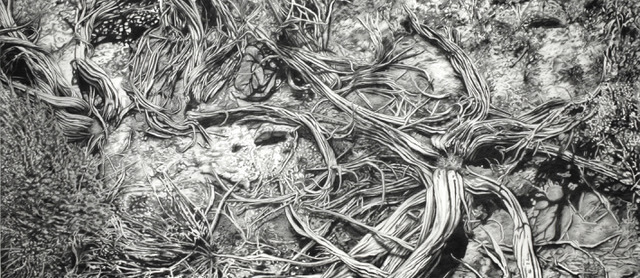Mary Oestereicher Hamill: regardisregard
Mary Oestereicher Hamill is a multi-media artist and pioneer of participatory photo-based art, shining a light on the needs of poor and marginalized people in our society.
When I arrived in Taos, New Mexico for my first fellowship at the Helene Wurlitzer Foundation, I had never worked with landscape. I had been focused on a series of working photographs and drawings called the Medusa Portraits which explore aspects of the “feminine” in relation to aging and the association of the “feminine” in Western philosophy and culture to earth and decay, even while it also has clear biological connections to birth and life. As I hiked the high desert in Taos, I was struck by the power of the New Mexican landscape and I decided to begin a parallel series incorporating ideas from the Medusa Portraits while working with landscape.

Cristina de Gennaro, Sage Drawing VIII, 2018, Charcoal on mylar, 42” x 96”, Courtesy of the artist
And, so, as I wandered the trails around Taos, I found myself turning my gaze downward towards the earth, drawn to the eroding sagebrush, weeds, and parched soil of the high desert floor and focusing on mundane spaces rather than grand vistas and sublime sunsets. These “humble” scenes reference decay as well as regeneration and mark the day-to-day erosion of a materiality bound by time, the “sublime” they explore is one tempered by the abject.
The serpentine forms embody the entropic process, capturing the transition from a state of growth to one of dissolution, and yet I find their dis-order, their decline, to be filled with movement, pattern, grace, and beauty, much like my aging body.
I photograph the plants, creating “panoramic” views of the desert floor. Later, working from the photographs in my studio, I draw the organic systems, exploring tensions between pattern and complexity, beauty and chaos.
The compositions are de-centered and claustrophobic: it’s difficult for the eyes to find a place to rest. These uncomfortable spaces are carefully rendered, though, creating simultaneous feelings of attraction and repulsion. My experience of aging is complex and filled with contradictions: age has brought not only knowledge and power, but fragility and loss – and these landscapes reflect that.
-Cristina de Gennaro
Cristina de Gennaro has exhibited her drawings and paintings, installations, videos, and performances in museums and galleries nationally including the Portland Art Museum (Portland, OR), the Brattleboro Museum and Art Center (Brattleboro, VT), the Glyndor Gallery at Wave Hill (Bronx, NY), Nexus Contemporary Art Center (Atlanta, GA), the Dallas Museum of Art (Dallas, TX), Portland Center for the Visual Arts (PCVA) (Portland, OR), San Antonio Museum of Art (San Antonio, TX), the Center on Contemporary Art (COCA) (Seattle, WA) and The Women’s Building (Los Angeles, CA), among others.
She has been the recipient of numerous artist residency fellowships including the Wurlitzer Foundation (Taos, NM), the Millay Colony (Austerlitz, NY), the Fundacion Valparaiso (Almeria, Spain), Saltonstall Foundation for the Arts (Ithaca, NY), the Jentel Foundation (Banner, WY), and was visiting artist at the American Academy in Rome (Rome, Italy) and the GlogauAIR Artist Residency Program (Berlin, Germany).
Her work has been reviewed in The New York Times, High Performance, Artweek, Seattle Post-Intelligencer, Dallas Times Herald, and The Oregonian, among others. She has received artist grants from the Pollock-Krasner Foundation, the National Endowment for the Arts, the Oregon Arts Commission, and the Portland Arts Commission.
Cristina de Gennaro received her MFA in Studio Art from Stanford University in 1995 and is currently adjunct professor of Art at William Paterson University and New Jersey City University.
Learn more at cristinadegennaro.com
In addition to inspiring people with our classes, we spark imaginations with world-class art installed on our terrace and in our galleries. We maintain the beautiful stone mill that deepens your ties with the past and provide a gathering place for your family and friends on the Toshiko Takaezu Terrace. Please consider making a tax-deductible donation so that we may continue educating, challenging, and inspiring community through the arts.
The Hunterdon Art Museum is barrier-free and accessible to people who use wheelchairs. Patrons who are deaf, hard of hearing or speech impaired may contact the Museum through the New Jersey Relay Service at (TTY) 1 (800) 852-7899. Visit our Accessibility page for complete information.
Programs are made possible in part by funds from the New Jersey State Council on the Arts, a partner agency of the National Endowment for the Arts; Hyde and Watson Foundation; The Large Foundation; and The Holt Foundation, along with other corporations, foundations, and individuals.
Mary Oestereicher Hamill is a multi-media artist and pioneer of participatory photo-based art, shining a light on the needs of poor and marginalized people in our society.